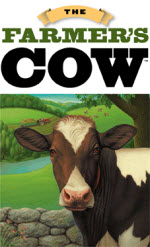

THE HISTORY OF DAIRY FARMING - THEN AND NOW
- For thousands of years, cows have been providing people with food (milk and meat), clothing (leather), labor (plowing), and fuel and fertilizer (manure.)
- In the old days, cows were probably somewhat neglected during the summer months when the farmer was busy with his crops.
- In the 1850's nearly all families had a cow. In villages and cities, people might not be able to have their own cows because there wasn't any land to graze on, so centralized dairy farming developed.
- Many dairy farms also grow their own feed such as alfafa, hay and corn, or own or lease pastures where the cows graze.
- Up until the late 1800's, cows were milked by hand. Cows were brought into a barn, and tied up or held in place with stanchions. Cows were milked from the side, which was safer, cleaner, more comfortable, kept the tail out of the milk pail and the farmer's face, and made it harder for the cow to kick the farmer.
- In 1862, pasteurization was first tested, and was adopted for milk in the early 1900s. The process uses heat to destroy harmful bacteria without significantly changing milk's nutritional value or flavor. In addition to killing disease-causing bacteria, pasteurization destroys bacteria that cause spoilage, extending the shelf life of milk.
- Today, automatic suction milking machines are used. The first such machine was invented in 1878, but many cows were still milked by hand as late as the 1940's. (Source: 4-H manual).
- To preserve milk, it must be kept cool. Before refrigeration, this was done by continuously pumping cold underground water around milk containers.
- Milk was sold directly by farmers, or delivered by the milkman in glass bottles.
- In the 1950's, scientists discovered that sperm can be frozen and then thawed to fertilize eggs and develop normal, healthy calves (called artificial insemination.) Today, about 60% of U.S. dairy calves are from artificial insemination. (Source: 4-H manual)
- Today there are dairy farms in all 50 states and Puerto Rico.
- Today there are more than 9.2 million dairy cows in the U.S., on 60,000 farms, producing 21 billion gallons of milk each year. (Source: Dairy Farming Today)
- About 99% of all U.S. dairy farms are family-owned and operated. The majority (77%) have less than 100 cows. (Source: Dairy Farming Today)
- When a dairy farm spents money locally, the effect on the economy is 2.5x the original dollar spent (Source: Dairy Farming Today)
- They are 150 licensed dairy farms in CT, and 19,000 cows in Connecticut. About ten of these dairy farms are located in Woodstock, CT. (National Agricultural Statistics Service, USDA, 2008 )
- Pasteurization -prevents ecoli, salmonella, listeria, etc.
Sources:
- Dairy Farming Today
- Wikipedia.org

Proud members of
The Farmer's Cow
Contact us at:
millerlonghill@snet.net
860.928.9483
Fairvue Farms LLC
199 Route 171
Woodstock, CT
06281-3127
All rights reserved. ©2008 Fairvue Farms LLC
If you experience difficulties viewing or have questions about the website please contact the webmaster.
Web design by Chimalis LLC
Web design by Chimalis LLC